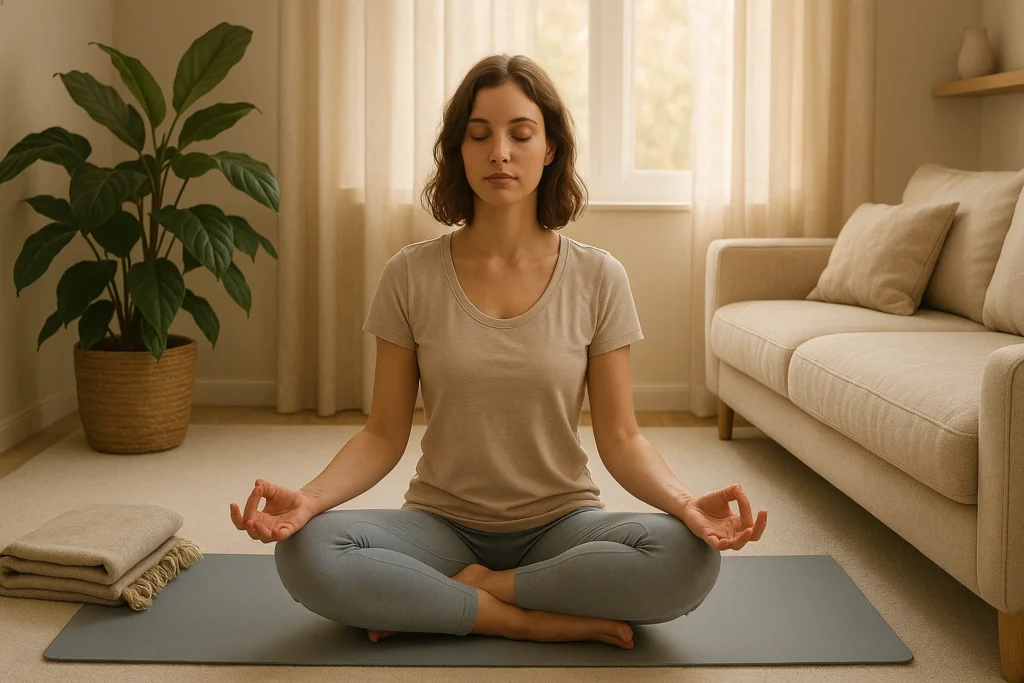
Escape the chaos. In a world that rarely slows down, finding real balance can feel out of reach. An ayurvedic yoga retreat blends Ayurveda’s wisdom with the calming power of yoga to help you reconnect. Think sunrise movement, warm oils, and the kind of food your body actually wants. This immersive experience—set in quiet, natural settings—brings together personalized treatments, mindful practice, and nourishing meals so your body, mind, and spirit can exhale. If you’re comparing formats and destinations, our yoga retreat guide is a handy deep dive.
Find Your Dosha Now!Table of Contents
What is an Ayurvedic Yoga Retreat?
An ayurvedic retreat is a focused wellness stay that weaves together two sister traditions: Ayurveda, the “science of life,” and yoga, the practice of steadying body and mind. Instead of a generic getaway, you get a plan shaped around you—how you sleep, digest, move, and handle stress.
Picture it: morning practice as the light changes, a warm Abhyanga oil massage that can encourage slower breathing, and meals cooked to match your constitution—simple, spiced, and easy to digest. The goal isn’t to “do more”—it’s to gently restore what’s been overdrawn.
Sarah, a marketing lead on the edge of burnout, tried a 7-day retreat in Rishikesh: “The personalized yoga and Ayurvedic meals helped me feel steady for the first time in months.” This kind of tailored approach—mindful movement plus dosha-specific therapies—aims to address underlying patterns, not just surface symptoms. Some studies suggest yoga may help with stress management; for context on benefits and safety, see the NIH’s National Center for Complementary and Integrative Health: Yoga. For practical tools you can use at home, explore our yoga and breathwork for stress relief.
Stepping away from notifications and routine makes room for deeper change. Many retreats are set in the Himalayas, on Kerala’s backwaters, or among Bali’s rice terraces—places where quiet comes naturally. If you’re mapping out ayurveda yoga travel, build in a buffer day to arrive, rest, and sync meals to local time. Next, a quick look at how Ayurveda sets the foundation.
This post has affiliate links. We may earn a commission. Learn more.
The Ancient Wisdom of Ayurveda
Understanding Your Dosha
Ayurveda teaches that health is an ongoing balance of body, mind, and spirit. A big part of that balance is your dosha—Vata, Pitta, or Kapha—the patterns that shape how you think, digest, sleep, and respond to stress. At an Ayurvedic retreat, a practitioner will discuss your routines, pulse, and symptoms to create a plan that fits you. Curious where you might land? Try our Ayurveda doshas quiz.
- Vata (Air & Ether): Fast, creative, and changeable. When imbalanced: anxiety, dryness, irregular digestion.
- Pitta (Fire & Water): Focused, driven, and warm. When imbalanced: irritability, heat, acidity.
- Kapha (Earth & Water): Grounded, steady, and caring. When imbalanced: heaviness, sluggish digestion, inertia.
Most of us are a blend—say Vata-Pitta—with one dominant. Knowing yours shapes your yoga style, meals, sleep routine, and even when you schedule rest.
Ayurvedic Principles for Balance
Retreats use a few simple, time-tested principles:
- Dinacharya: Daily rhythm—wake, move, eat, and wind down at consistent times.
- Ritucharya: Seasonal tweaks—lighter in summer, warmer and oilier in winter.
- Ahara: Food that matches your dosha and supports easy digestion.
- Vihara: Balanced activity—effort paired with real recovery.
- Oushadha: Gentle herbal support when needed, not forever prescriptions.
Put together, these choices steady your system. For daily how-tos, see our Ayurvedic daily practices guide. For the big-picture planning piece, our planning guide can help you compare formats and timelines. Now, here’s how yoga ties in.
Yoga: The Perfect Partner for Ayurveda
Yoga is more than exercise; it’s a way to organize your attention and breath so the body can follow. At an Ayurvedic wellness retreat, classes are tailored to your dosha—slow, steady, and grounding for Vata; cooling and uncluttered for Pitta; energizing and a bit brisk for Kapha.
Core Elements of Yoga
Expect these pillars, adjusted to suit your energy and needs:
- Asana: Postures for strength, mobility, and organ health—without chasing extremes.
- Pranayama: Breath practices that calm the nervous system and build steady energy.
- Meditation: Simple, consistent techniques that clear mental noise.
- Dhyana: Uninterrupted focus—what steadiness feels like from the inside.
- Yama & Niyama: Gentle ethics and habits that make healthy choices easier to keep.
As the Bhagavad Gita puts it, yoga is ultimately an inward journey. Paired with Ayurveda, it becomes practical: what to eat, when to move, how to rest.
For foundations and philosophy in plain language, see our guide to yoga philosophy. Next up: a day on retreat.
A Day at an Ayurvedic Yoga Retreat
Every retreat has its own flavor, but the rhythm is familiar: regular meals, right-sized movement, and real downtime. Here’s a sample day (yours will vary):
| Time | Activity | Description |
|---|---|---|
| 6:00 AM | Morning Meditation | Unplug, sit, breathe—set a simple intention for the day. |
| 7:00 AM | Dosha-Specific Yoga | Grounding for Vata, cooling for Pitta, uplifting for Kapha—adapted to you. |
| 8:00 AM | Ayurvedic Breakfast | Warm, easy-to-digest dishes (think spiced porridge or khichdi). |
| 10:00 AM | Ayurvedic Consultation | Refine your plan: digestion, sleep, energy, stress—what’s changing? |
| 11:00 AM | Therapeutic Treatment | Abhyanga oil massage, Shirodhara, or other therapies to settle the nervous system. |
| 1:00 PM | Dosha-Balancing Lunch | Fresh, seasonal, and simple—spices adjusted to your constitution. |
| 3:00 PM | Workshop | Learn basics: Ayurvedic cooking, herbs, or how to keep a routine at home. |
| 5:00 PM | Evening Yoga & Pranayama | Restorative shapes and quiet breath to cue sleep. |
| 7:00 PM | Light Dinner | Vegetable-forward and simple so digestion can rest overnight. |
| 8:00 PM | Group Reflection | Share a takeaway or sit together in silence—no pressure to perform. |
This kind of consistency can lower friction: fewer decisions, more space for recovery. When planning ayurveda yoga travel, keep the daily rhythm simple so the gains stick. Wondering what changes to expect? Here are the common benefits.

Benefits of an Ayurvedic Yoga Retreat
A well-run wellness program may offer common benefits—supported by emerging research and guest reports:
- Lower Stress Load: Regular breath, slower pace, and supportive therapies calm the system.
- Happier Digestion: Warm, simple meals and consistent mealtimes reduce bloat and heaviness.
- More Steady Energy: Routines match your capacity, so you feel fueled rather than depleted.
- Clearer Headspace: Meditation and quiet time trim the mental noise.
- Emotional Ease: Personalized practices build resilience when you return home.
Ayurvedic Wellness Travel: Quick Planning Tips
- Match season to your dosha (cooler for Pitta; warm, steady routines for Vata; light, active days for Kapha).
- Budget for therapies and transfers—oils and daily treatments add value beyond headline room rates.
A 2020 paper in Frontiers in Psychology reported associations between mindfulness practices and improved emotional regulation. Many guests echo the same theme: “lighter, clearer, and more connected.”
When choosing a retreat, look for practitioner credentials, clear daily schedules, and reviews that mention care and follow-through. Kerala and Rishikesh are classics; Bali and Sri Lanka offer excellent options too.
Discover Your Dosha: Interactive Quiz
One minute, three questions. Find your likely dominant dosha and get simple next steps.
How would you describe your energy levels?
Who Should Attend?
If you want a reset that feels kind—not extreme—this is for you. Stressed professionals, new parents, athletes between cycles, and absolute beginners all do well because programs scale to your level. Curiosity about holistic health is enough; the retreat holds the structure.
Holistic Retreat Guide: Choosing & Preparing
Use this holistic retreat guide to choose confidently: look for practitioner bios, clear daily schedules, and reviews that mention follow-through after the retreat—not just the views. Budget for 7–14 days for deeper results, and check if destinations like Kerala or Bali align with your dosha’s needs. Our yoga retreat guide dives deeper into cost and logistics.
- Match climate to needs (cooler for Pitta; warmer routines for Vata; drier, active days for Kapha).
- Confirm intake: questionnaire + consultation + mid-week adjustments.
- Ask about food style (seasonal, moderate spice, caffeine/alcohol policy).
- Check group size and teacher-to-guest ratio for real attention.
Frequently Asked Questions
Conclusion: Embrace Your Journey to Wellness
An ayurvedic yoga retreat is a gentle way to rebuild steadiness: personalized yoga, simple nourishing food, and therapies that calm the noise. If you’re considering ayurvedic wellness travel, start with the quiz above to learn your likely dosha, then pick a retreat that fits your life—not the other way around.


